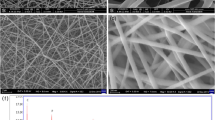Abstract
Conducting electroactive polymers are promising candidates for next-generation sodium-ion batteries due to their environmentally benign properties, high stability, and low cost. In this work, polyaniline (PANI) nanofibers have been successfully prepared by interfacial polymerization and characterized using Fourier transform infrared (FTIR) spectroscopy and scanning electron microscopy (SEM). The effect of initiator concentration and interfacial contact area on the yield and surface morphology of PANI nanofibers has been studied. The yield and nanofibrous structure of PANI are found to be directly proportional to the interfacial contact area and the concentration of initiator. PANI nanofibers prepared from 1 M ammonium persulfate (APS) in a container having highest interfacial area of 200 cm2 has the highest yield of 0.9 and uniform nanofibrous structure which is clear from SEM study. Preparation of PANI nanofibers and doping with sodium-ion salt is confirmed by FTIR spectroscopy. Sodium-ion battery prepared with doped PANI delivered a highest discharge capacity value of 112 mAh g−1 at 0.047 mA cm−2 during initial cycling. The rate capability tests indicated that after cycling at different C-rates, the cell regained its initial discharge capacity value of 123 mAh g−1 at 0.047 mA cm−2.
Graphical abstract











Similar content being viewed by others
References
MacDiarmid AG (2001) “Synthetic metals”: a novel role for organic polymers. Angew Chem Int Ed 40:2581–2590
Shirakawa H (2001) The discovery of polyacetylene film: the dawning of an era of conducting polymers. Angew Chem Int Ed 40:2574–2580
Heeger AJ (2001) Semiconducting and metallic polymers: the fourth generation of polymeric materials. Angew Chem Int Ed 40:2591–2611
Novak P, Muller K, Santhanam KSV, Haas O (1997) Electrochemically active polymers for rechargeable batteries. Chem Rev 97:207–282
Manuel J, Kim JK, Matic A, Jacobsson P, Chauhan GS, Ha JK, Cho KK, Ahn JH (2012) Electrochemical properties of lithium polymer batteries with doped polyaniline as cathode material. Mater Res Bull 47:2815–2818
Manuel J, Kim M, Fapyane D, Chang IS, Ahn HJ, Ahn JH (2014) Preparation and electrochemical properties of polyaniline nanofibers using ultrasonication. Mater Res Bull 58:213–217
Boom RM, Wienk IM, Boomgaard TVD, Smolders CA (1992) Microstructures in phase inversion membranes. Part 2. The role of a polymeric additive. J Membr Sci 73:277–292
Huang J, Kaner RB (2004) Nanofiber formation in the chemical polymerization of aniline: a mechanistic study. Angew Chem Int Ed 43:5817–5821
Stejskal J, Sapurina I, Trchova M (2010) Polyaniline nanostructures and the role of aniline oligomers in their formation. Prog Polym Sci 35:1420–1481
Ning G, Haran B, Popov BN (2003) Capacity fade study of lithium-ion batteries cycled at high discharge rates. J Power Sources 117:160–169
Acknowledgements
We acknowledge Southern Company Services for financial support through the GRAPE Grant (#053967-01). Authors also would like to acknowledge Gregory Neher for his help during laboratory experiments.
Author information
Authors and Affiliations
Corresponding author
Additional information
Publisher’s Note
Springer Nature remains neutral with regard to jurisdictional claims in published maps and institutional affiliations.
Rights and permissions
About this article
Cite this article
Manuel, J., Salguero, T. & Ramasamy, R.P. Synthesis and characterization of polyaniline nanofibers as cathode active material for sodium-ion battery. J Appl Electrochem 49, 529–537 (2019). https://doi.org/10.1007/s10800-019-01298-y
Received:
Accepted:
Published:
Issue Date:
DOI: https://doi.org/10.1007/s10800-019-01298-y




